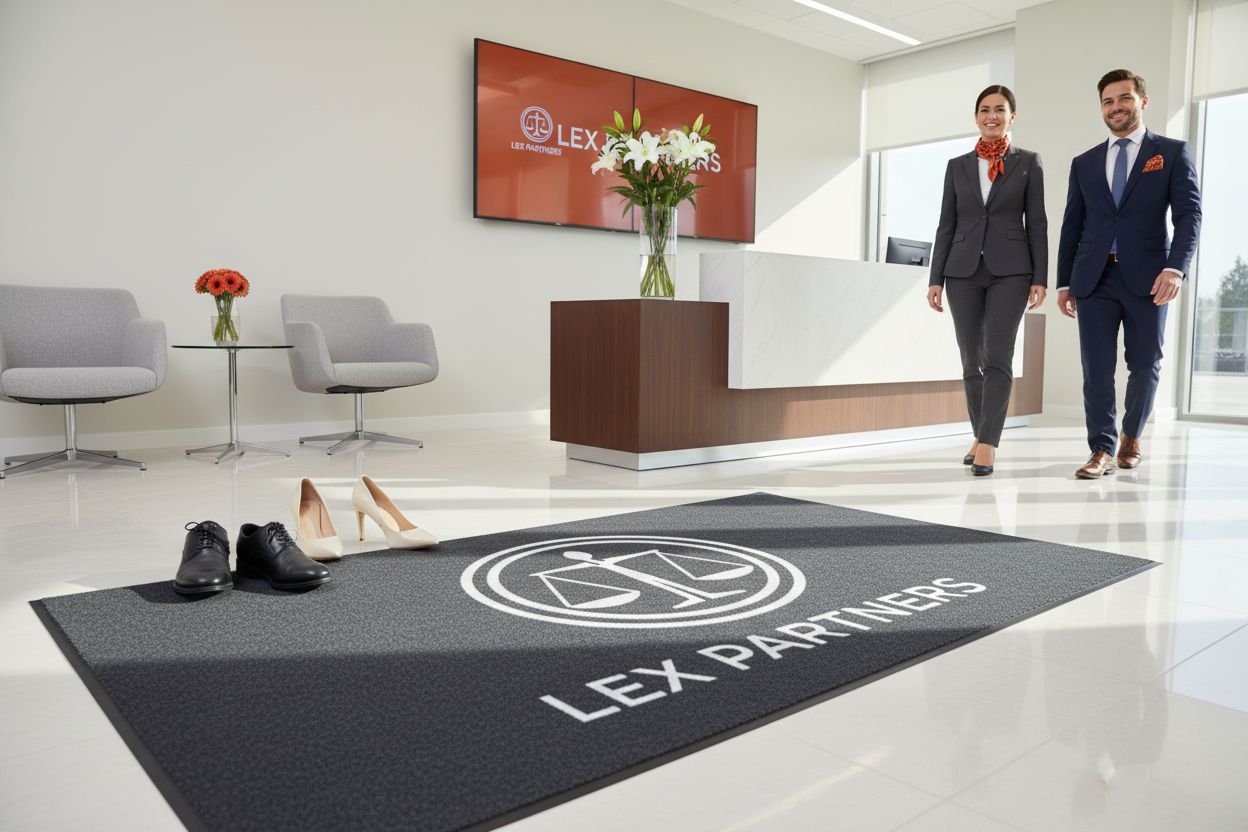First impressions in business happen fast—people form opinions within just seven seconds of meeting someone. These snap judgments impact everything from client trust to career growth. The smallest details, like a polished reception area or a branded entrance mat, can tip the scales in your favour. By paying attention to both personal appearance and workspace design, businesses lay the groundwork for strong relationships and ongoing opportunities.
Table of Contents
- Defining First Impressions In Business Environments
- Psychological Impact On Clients And Visitors
- First Impressions And Corporate Branding
- Real-World Examples: Mats And Interior Design
- Risks Of Neglecting Entrance Presentation
Key Takeaways
| Point | Details |
|---|---|
| Importance of First Impressions | First impressions in business are formed within seconds and significantly influence perceptions of competence and reliability. |
| Psychological Influence of Environment | Entrance design and cleanliness impact visitors’ psychological comfort, contributing to their overall impression of the organization. |
| Strategic Branding through Design | Every element of a business’s physical space, from mats to reception areas, can convey brand identity and professionalism. |
| Consequences of Neglect | Poorly maintained entrances can deter potential clients and damage business relationships by indicating a lack of attention to detail. |
Defining First Impressions in Business Environments
In the fast-paced world of business, first impressions are split-second judgments that can make or break professional opportunities. According to Psychology Today, these initial assessments are formed within mere seconds of encountering someone, creating a lasting impact on subsequent interactions.
These rapid evaluations extend far beyond personal interactions. In professional environments, first impressions shape perceptions of competence, reliability, and potential. Research suggests that individuals form complex judgments about a person’s capabilities, trustworthiness, and professional potential within the first few moments of an encounter. This instantaneous assessment can influence critical decisions such as hiring, partnership opportunities, and career progression.
The psychology behind first impressions is fascinating. Our brains are hardwired to make quick evaluations as a survival mechanism, rapidly processing visual, verbal, and non-verbal cues. In business settings, these cues might include professional attire, communication style, body language, and even the environments we create. A well-designed office entrance, strategically placed logo mat, or meticulously maintained reception area can significantly contribute to the initial impression a business makes on clients, partners, and potential employees.
Here’s a comparison of key elements influencing first impressions in business environments:
| Element | Impact on Perception | Example in Business Space |
|---|---|---|
| Professional Attire | Conveys competence & trust | Well-dressed staff |
| Communication Style | Signals confidence | Clear, polite greetings |
| Body Language | Suggests openness/reliability | Confident posture Firm handshake |
| Reception Area Design | Reflects professionalism | Organised, branded reception |
| Logo/Entrance Mats | Reinforces brand identity | Company-branded entrance mat |
| Cleanliness | Indicates attention to detail | Pristine floors Neat workspace |
Understanding the power of first impressions allows businesses to be intentional about their presentation. By recognizing that every detail matters – from personal grooming to workspace design – organisations can craft positive, memorable first encounters that open doors to future opportunities.
Psychological Impact on Clients and Visitors
The psychological landscape of business interactions is profoundly influenced by initial environmental experiences. According to research from Open Entrances, entrance design plays a critical role in shaping visitors’ psychological responses and setting the emotional tone for their entire interaction.
One of the most intriguing psychological phenomena at play is the halo effect. As Psychology Today explains, this cognitive bias means that a positive initial impression can unconsciously create assumptions of broader positive qualities. In business contexts, this translates to a well-designed reception area or thoughtfully placed entrance mat potentially generating perceptions of professionalism, attention to detail, and organisational competence.
Visitors subconsciously process multiple sensory cues upon entering a space. The texture of a floor mat, the cleanliness of an entrance, the strategic placement of branding elements, and the overall aesthetic can significantly influence comfort levels and openness. A welcoming, meticulously maintained entrance communicates respect, professionalism, and a commitment to quality that extends far beyond mere aesthetics.
By understanding these psychological mechanisms, businesses can intentionally design their entry points as powerful communication tools. A strategically curated entrance becomes more than a physical space – it’s a silent ambassador that speaks volumes about the organisation’s values, culture, and approach to client relationships before a single word is exchanged.
First Impressions and Corporate Branding
Corporate branding transcends mere visual design – it’s a comprehensive communication strategy that begins the moment a client or visitor encounters your business space. According to the UK News Group, first impressions are so powerful that they can permanently shape perceptions, making it crucial for businesses to meticulously align their physical environment with their brand identity.
The visual narrative of corporate branding extends far beyond logos and colour schemes. As highlighted by the Entrepreneur Handbook, elements such as appearance, professionalism, and attention to detail collectively reinforce a company’s professional image. This means every touchpoint – from reception areas to entrance mats – becomes an opportunity to communicate brand values and organisational philosophy.
Strategic branding elements like custom logo mats, professionally designed signage, and consistent colour palettes create a cohesive visual language that speaks directly to clients’ subconscious perceptions. These subtle yet intentional design choices communicate professionalism, reliability, and a commitment to quality before any verbal interaction occurs. A well-designed entrance mat featuring a company logo, for instance, can instantly convey brand confidence and attention to detail.

Understanding that first impressions are virtually immutable, successful businesses invest in creating holistic brand experiences. By carefully curating every aspect of their physical environment, organisations can transform their spaces into powerful brand ambassadors that communicate their core values, professionalism, and unique identity instantaneously.
Real-World Examples: Mats and Interior Design
The power of first impressions extends far beyond abstract concepts, manifesting tangibly through strategic interior design choices. According to Open Entrances, entrance design profoundly influences visitor psychology, transforming seemingly mundane elements like floor coverings into powerful communication tools.
In corporate environments, entrance mats serve as more than functional floor coverings. They are strategic brand ambassadors that communicate organisational values before a single conversation occurs. For instance, a law firm using a meticulously crafted logo mat in their reception area instantly signals professionalism, attention to detail, and brand confidence. Maximise Your Brand Visibility with Branded Mats demonstrates how thoughtfully designed mats can elevate a company’s visual narrative.
Research from Clear Facility Services highlights that the cleanliness and design of office spaces significantly impact client retention. A pristine entrance with a well-maintained, professionally designed mat communicates respect, hygiene, and operational excellence. Healthcare facilities, educational institutions, and high-end corporate offices increasingly recognise that these subtle design elements play a crucial role in shaping visitor perceptions.
By understanding that every design element tells a story, businesses can transform their entrances into strategic experiences. From colour-coordinated logo mats to carefully selected floor coverings that reflect organisational identity, these seemingly small details can create powerful, lasting first impressions that resonate far beyond the initial encounter.
Risks of Neglecting Entrance Presentation
Neglecting the visual and functional aspects of a business entrance can have surprisingly profound consequences. According to research from Open Entrances, entrance presentation directly influences visitors’ psychological comfort and openness, making it a critical first point of interaction.
A poorly maintained entrance communicates volumes about an organisation’s professionalism and attention to detail. Clear Facility Services warns that substandard entrance conditions can significantly deter potential clients, potentially damaging business relationships before they even begin. Worn-out mats, dirty floors, and cluttered reception areas send subtle yet powerful messages about an organisation’s operational standards and overall competence.
The risks extend beyond mere aesthetic concerns. Visitors unconsciously interpret entrance conditions as indicators of broader organisational practices. A disheveled entrance suggests potential systemic inefficiencies, potentially raising questions about the company’s reliability, hygiene standards, and commitment to quality. Understanding Outdoor Mats for Wet Areas highlights how even practical elements like entrance matting can significantly mitigate risks such as slip hazards and maintain a professional appearance.
Businesses must recognise that entrance presentation is not a superficial concern but a critical communication channel. Every element – from logo mats to floor cleanliness – contributes to a comprehensive narrative about the organisation’s values, professionalism, and commitment to excellence. Neglecting these details can inadvertently create barriers that prevent meaningful client engagement and opportunities.
![]()
Enhance Your Business Entrance with Custom Mats That Make a Lasting First Impression
First impressions in business set the tone for every interaction that follows. This article highlights how subtle details like entrance mats and reception area design can influence client trust, convey professionalism, and reinforce your brand identity. If you want to avoid risks like poor visitor perceptions or missed opportunities, investing in well-designed, custom floor coverings is essential. These mats not only protect your premises but act as silent ambassadors of your organisation’s values and attention to detail.
Discover how custom mats tailored to your specific industry and branding needs can elevate your business environment. From logo mats to anti-slip solutions, Mats4U offers a wide variety of durable, made-to-measure options that help you create the perfect first impression that lasts.

Transform your entrance into a powerful visual statement today. Explore our full range of custom mats and floor coverings and take the first step towards making every visitor feel welcome and confident in your professionalism. Visit Mats4U now and find the ideal mat solution to support your brand and business goals.
Frequently Asked Questions
What factors influence first impressions in business environments?
First impressions in business are influenced by professional attire, communication style, body language, office reception design, and cleanliness. These elements shape perceptions of competence, reliability, and professionalism.
How can businesses design their entrance to create positive first impressions?
Businesses can create positive first impressions by focusing on entrance design, maintaining cleanliness, and including branded elements like logo mats. A welcoming and organized reception area contributes significantly to visitors’ comfort and openness.
What is the halo effect, and how does it relate to first impressions?
The halo effect is a cognitive bias where a positive first impression leads to assumptions of broader positive qualities. In a professional context, a well-designed entrance can suggest professionalism and trustworthiness, influencing how clients perceive the business overall.
Why is neglecting entrance presentation a risk for businesses?
Neglecting entrance presentation can indicate poor attention to detail, potentially deterring clients. A disorganized or unclean entrance may lead visitors to question the overall reliability and quality of the organization, impacting business relationships before they even start.









